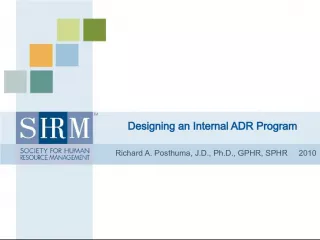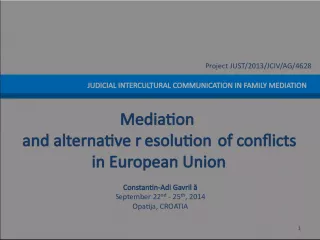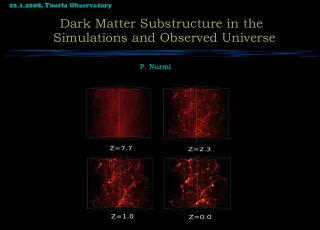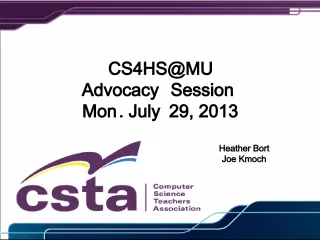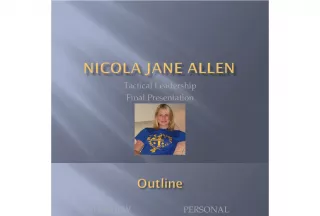Conflict Resolution Plan & Recall for OT


The presentation covers conflict resolution in OT, including types of conflicts, disguised conflict resolution in GB theory, and recalling OT's constraint-based architecture and principle conflict resolution with a historical perspective.
- Uploaded on | 2 Views
-
 susie
susie
About Conflict Resolution Plan & Recall for OT
PowerPoint presentation about 'Conflict Resolution Plan & Recall for OT'. This presentation describes the topic on The presentation covers conflict resolution in OT, including types of conflicts, disguised conflict resolution in GB theory, and recalling OT's constraint-based architecture and principle conflict resolution with a historical perspective.. The key topics included in this slideshow are . Download this presentation absolutely free.
Presentation Transcript
1. Conflict Resolution Plan of Today’s Presentation 1. Discuss conflict resolution as rule ordering 2. Introduce types of conflicts 3. Discuss the disguised conflict resolution component of the GB- theory 4. Discuss the conflict resolution in the MP
2. Conflict Resolution Recall: OT is a grammatical architecture that is constraint based. We discussed the constraints/ representation vs. derivation issue yesterday. The principles/constraints are allowed to be in conflict with each other. A historical perspective on this is today‘s topic.
3. Precursors and Background: conflict resolution • The notion of conflicts, central to OT, has not really been identified as such in older theories, though it is evident that conflicts and their resolution played at all times an important role. • In a nutshell, derivational theories use the device of rule ordering to solve potential conflicts, and representational theories formulate constraints on the kind of phonological structures licensed by Universal Grammar.
4. Conflicts in derivation and in representations Formulated from a different perspective : In a derivation model, conflicts between rules arise when two rules are applicable at the same time - so that one has to decide which rule applies, and which rule doesn’t
5. The Import of Rule Ordering The Import of Rule Ordering Recall the example we discussed yesterday Recall the example we discussed yesterday First dialect (Standard German) /lang/ First dialect (Standard German) /lang/ la ˜ g Assimilation of ˜ to g la ˜ g Assimilation of ˜ to g la ˜ g-deletion la ˜ g-deletion – Final Devoicing [la ˜ ] – Final Devoicing [la ˜ ] Second dialect (Northeren German) /lang/ Second dialect (Northeren German) /lang/ la ˜ g Assimilation of ˜ to g la ˜ g Assimilation of ˜ to g lank Final Devoicing lank Final Devoicing – g-deletion [la ˜ k] – g-deletion [la ˜ k]
6. Rule Ordering in Syntax : Case A simple example for the need for rule ordering comes from the interaction of Case theory and other rules of grammar. Suppose that Case is assigned to a noun phrase whenever it stands in a certain local relation to a verb, a preposition, etc ....
7. Case & wh-Movement In German, Case must be assigned to a noun phrase BEFORE it is moved to sentence initial position in a question ... Wen denkst du dass sie liebt who-acc think you that she loves ... Because the noun phrase would be too far away from the verb after it has been preposed
8. Case & wh-Movement This looks like intrinsic rule order in phonology ... Note however that noun phrases sometimes (have to) pick up Case after wh-movement *je crois Jean être intelligent I believe John to be intelligent qui crois-tu être intelligent who believe.you to be intelligent or in Hungarian, in Quechua ...
9. Case & passive later than In German, accusative Case assignment must come later than passivization, because otherwise, the wrong Case pattern would be generated dass der Mann angerufen wird that the-nom man called up is *dass den Mann angerufen wird that the-acc man called up is
10. Case & passive In Ukrainian, Hebrew, North Russian and other languages, accusative Case may, however, show up in passives. We thus need extrinsic rule ordering, too German: passive > accusative Ukrainian: accusative > passive
11. Conflict Resolution: Pre-OT Models The leading idea of generativism has always been to formulate as explicit rules for language as possible The more explicit and detailed rules are, the less likely they are to run into conflicts ... but recall the problems w.r.t. the loss of generalizations, etc.
12. Conflict Resolution Plan of Today’s Presentation 1. Discuss conflict resolution as rule ordering 2. Introduce types of conflicts 3. Discuss the disguised conflict resolution component of the GB- theory 4. Discuss the conflict resolution in the MP
13. Kind of conflicts found in phonology 1. Markedness vs. faithfulness Phonological outputs are torn between the desire to be unmarked, and so fulfill the basic phonology of the language, and the desire to be faithful to their underlying representations, which can be badly marked. These basically conflicting tendencies is found in all domains of phonology.
14. Markedness Markedness is a rather vague term, though crucial in phonology. It has received several different definitions : • A marked segment is less natural, more complex, less common, not basic, it appears later in language acquisition, in fewer languages, in less positions, it is not readily subject to neutralization, harder to articulate, perceptually more salient, etc.
15. Markedness – Nasal vowels are more marked than oral ones (all languages that have nasal vowels also have oral ones) – Voiced obstruents are more marked than voiceless ones (obstruents have a tendency to be voiceless). – Voiced sonorants are less marked than voiceless ones (sonorants have a tendency to be voiced). – Open syllables are less marked than closed ones.
16. Markedness Some diagnostics for markedness: - Implication: the marked feature or segment implies the unmarked one. - Frequency: unmarked features are more frequent than marked ones. - Processes: the marked features emerge only under special circumstances (otherwise emergence of the unmarked), the unmarked feature neutralizes more easily.
17. Markedness vs Faithfulness A further example for unmarkedness: the most unmarked syllable structure is an open syllable with an onset (CV). Languages are confronted with inputs which cannot be syllabified straightforwardly in a series of CVs. Some languages are faithful to their inputs (German Strumpfs ‘sock, gen.’), Others prefer unmarkedness ( Arbeit ‘work’ in Japanese is aribaatu , and the expression merry Christmas in Hawaiian is mele kelikimaka ).
18. Markedness vs Faithfulness In a purely derivational model, rules are expressed which account for repair. Examples of rules responsible for the absence of coda: C –> Ø / V _ C Ø –> V / C_C But remember that rules can be formulated whose aim is the reverse of unmarkedness, because the format of the rules does not show their aim.
19. Markedness vs Faithfulness In a representational model, syllable templates are postulated to which the individual segments dock to. Unsyllabifiable segments are either deleted or licenced through creation of a new syllable (vowel epenthesis). Remember Palestinian Arabic. / | \ / | / | \ C V C –> C V C V C d a r s d a r i s
20. Markedness vs Faithfulness Representations do not really escape rules. However the aim of processes has become much clearer, since now, the aim of a rule is included in its format. • A vowel is epenthesized in order to allow the syllabification of an otherwise unsyllabifiable C. • It is not possible to formulate a rule which is ill-formed w.r.t. a certain representation. Remember the possible and impossible assimilations of last time.
21. Markedness vs Faithfulness Hiatus avoidance is another example for markedness vs faithfulness. Last time we only saw examples of languages which avoid hiatus, at least in some circumstances, thus of languages favoring unmarkedness. Some languages (Maori, Hawaiian) tolerate hiatus much more easily. These languages favor faithfulness.
22. Avoidance of hiatus The languages of last time have cases in which hiatus is not repaired, however. First French and consonant deletion: L’ami vs elle a un enfant . In the case of l’ami , schwa in the article is elided. Notice that part of the article is still present and pronounced.
23. Avoidance of hiatus In elle a un enfant , a or un can not be elided, since elision would lead to complete deletion of the morpheme. Elle un enfant or elle a enfant . The tendency to unmarkedness can be hindered by a more important tendency (here the tendency to realize morphemes phonetically). (This is a case of do something except when …)
24. Avoidance of hiatus In rule ordering, the restriction against vowel deletion in case it stands for a whole morpheme is difficult to express. It is a restriction on the environment of the rule application. V –> Ø/ –V (except when …) (It is not an elsewhere condition, since elsewhere condition concerns two rule, the environment of one includes the environment of the other.)
25. Avoidance of hiatus In a representational model, it is again the tendency to unmarked syllable structure which triggers the process. / \ | / | C V V –> C V l e ami l a mi
26. Avoidance of hiatus Second case, consonant insertion in German: Cha?ót vs Théo A consonant is inserted between two vowels in a hiatus position, except when the second syllable is unstressed. In one case markedness wins (when a glottal stop is inserted), in the other case, faithfulness wins.
27. Avoidance of hiatus The intuition is that it is more important for a stressed syllable than for an unstressed syllable to begin with a consonant. In rule ordering, we have stress assignment first, then glottal stop insertion. In other words syllable structure, stress assignment, then again syllable structure (repair).
28. Avoidance of hiatus In a representational model, we need to require a consonant at the beginning of a foot (since a stressed syllable begins a foot). F / \ / | \ /|\ ÷ A l pen
29. Avoidance of hiatus In Maori and Hawaiian (in some contexts, since Hawaiian has glide formation in some other environments), faithfulness wins. There is just no rule repairing hiatus. In a representational model, syllables do not need onsets.
30. Avoidance of hiatus Comparing French, German and Maori, the fact that syllable templates are different in the three languages must be formulated as an independent fact of the language. It is an accident that Maori tolerates more onsetless syllables than English and German and that German requires onsets for their stressed syllables.
31. Kind of conflicts found in phonology 2. Markedness vs. markedness • Different modules of phonology make different predictions. • One aspect of phonology can require some kind of unmarked structure and another aspect some other unmarked structure for the same segmental or syllabic material.
32. Metrical phonology A good place to look for conflicts between 2 kinds of markedness is Metrical phonology. Trochaic-Iambic Law (Hayes 1995) A canonical trochee ( ' ) consists of two equal syllables, in which both s have the same weight, (mono- or bimoraic, or just syllables). In contrast, a canonical iamb ( ' ) consists of unequal syllables: is lighter than '
33. Metrical phonology This requirement is conflicting with the requirement that all syllables have the structure CV. • To produce good iambs, French lengthens the last syllable but Beduin Arabic reduces the first syllable. Kitib becomes k.tib (McCarthy 2000) The first syllable looses its vowel and becomes badly marked. However it is more important for the language to respect the requirement of a good iamb. Final [b] is extrametrical.
34. Metrical phonology • A purely derivational approach to phonology has problems with metrical facts. SPE proposed a complex system of ordered rules to account for stress in English, in which stress was an ordinary feature [±stress] but as Liberman & Prince showed, some of the basic properties of stress cannot be accounted for in such a model.
35. Metrical phonology The special properties of stress (in comparison with segmental features) • - stress is associated with a syllable (not to a segment) • - relativity (a syllable is stressed only in comparison with an adjacent unstressed or less stressed one) • - no invariant phonetic correlate • - no assimilation
36. Metrical phonology Representational approach of Liberman & Prince: Metrical tree w s / \ / \ w s / s / \ / \ / / \ s w s w w s w Belgian farmers grow turnips
37. Metrical phonology Metrical grid x x x x x x x x x x x x x x Belgian farmers grow turnips Both metrical methods were heavily loaded with derivational methods
38. Metrical phonology Prince (1990), Hayes (1995) and others proposed an inventory of feet, to which syllables associate. However, a great deal of repairs are necessary (extrametricaliy, degenerate feet and the like) OT is more elegant.
39. Kind of conflicts found in phonology 3. Alignment and other requirements The last kind of conflict that will be mentioned today has to do with alignment effects. Some phonological entities want to be as near the edges of constituents as possible. This is true of stress for instance. Some other entities want to be associated with entities of a different kind as themselves.
40. Alignment Tones of intonation languages want to be associated with syllables of a certain kind: pitch accents with accented syllables, boundary tones with final syllables. Tones of tone languages want to be assiciated with syllables in a one-to-one fashion. The ideal autosegmental representation is the one in which there is exactly one tone per syllable and one syllable per tone. However, this is not always possible to fulfill.
41. Alignment Melodies, say HLH or HL, have been shown by Goldsmith, Leben, Williams and others to exist independently of words. And of course, words exist independently of melodies. In a HLH melody, the perfect tone-to-syllable association only obtains in case the word the melody associates with is three syllables long, otherwise there is a conflict between the number of tones and the number of syllables.
42. Alignment • Usually, tone and syllable association takes place left-to- right on a one-to-one basis until no tone is left. Then the last tone associates with the remaining syllables (spreading). • In a rule format, this kind of association is impossible to describe. • It is thus no accident that the first mainstream nonlinear phonological theory (so-called autosegmental phonology) has been developed first for tone phonology.
43. Alignment • Syllables and tones are represented on different tiers and association procedes in a certain way (one-to-one, from left- to-right etc.) • However, as in the case of stress, autosegmental representations are not enough. Rules are still necessary to decide how deviant cases of tone association are decided.
44. Alignment • A famous case is the so-called Meeussens Law: H # H --> H # L (Dissimilation rule) In Shona né#hóvé –> né#hove Iteration from left to right: sé#né#hóvé –> sé ne hóvé *sé ne hove This is a rule, applying on a representation.
45. Alignment Autosegmental phonology as a mixture of representation and ordered rules was very successful. Its methods were generalized on other domains of phonology, like metrical and segmental phonology.
46. Alignment Remember the problems that were identified last time w.r.t. ordered rules: - unconstraindedness - duplication - conspiracy The addition of a representational component to phonology was really a progress, because the uncontraindedness was not a concern anymore.
47. Alignment But no nonlinear model can resolve the problem of duplication or conspiracy. Duplication is probably even more acute in representations than in rules. Conspiracy is not resolved
48. Conflict Resolution Plan of Today‘s Presentation 1. Discuss conflict resolution as rule ordering 2. Introduce types of conflicts 3. Discuss the disguised conflict resolution component of the GB- theory 4. Discuss the conflict resolution in the MP
49. Conflicts in Syntax As we will see, the distinction between markedness, faithfulness, and alignment constraints can be made in syntax, too. We will focus now on the issue of how conflicts between constraints have been treated/circumvented in GB theory
50. Disguised Conflicts in GB In a representational model such as GB, there seems to be no need for conflict resolution à la rule ordering. At least the intrinsic rule ordering case discussed above (wh-movement and Case) can be restated easily in terms of trace theory: who do you think that she loves t Case goes to t and is then transmitted
51. Disguised Conflicts in GB But for the correct account of the passive, we still need to assume that passivization precedes Case assignment ... This is a matter or architecture in GB: passivization happens in the lexicon, and therefore precedes even D-structure ...
52. Disguised Conflicts in GB It may thus seem not unlikely that GB shifted its conflicts into the grammatical architecture. And there is some evidence that this is a correct view ...
53. The architecture of GB LEXICON D-Structure Move! S-Structure Phonetic Logical Form Form
54. The architecture of GB Lexical Processes precede EVERYTHING Passive formation Causative formation Where does the rule apply? America is inhabited by many people America is uninhabited by many people
55. Constraints at D-S and at S-S It is a consequence of the theory of thematic roles that an object should be the first sister of the verb to which is belongs semantically: I think that John loves Mary *I think Mary that John loves He told Mary that it was raining He told that it was raining Mary
56. Constraints at D-S and at S-S But in a passive, the semantic object placed in front of the subject position he was invited _ by Mary and in a raising situation, it moves even further he seems to be invited _ by Mary
57. Constraints at D-S and at S-S This displacement is due to the EXTENDED PROJECTION PRINCIPLE*: Every clause must have a filled subject position The conflict between theta-theory and the EPP* is resolved in favor of EPP*
58. Constraints at D-S and at S-S A conflict between EPP* and the theta- theory is avoided in GB by two assumptions: not EPP* need not hold at D-structure (so that D-S can be constructed without a conflict with EPP*) The theta-theory is respected at S-structure due to trace theory
59. Constraints at D-S and at S-S he seems to be invited t by Mary The arguments that theta-theory must hold after D-S are not very compelling, however ... No movement into theta-positions but these are not empty ... but these have no „attraction“ potential
60. Constraints at D-S and at S-S Bill is easy to please __ is easy to please Bill Maybe there IS movement to „theta- positions“ So we might simply say: Theta-theory: D-S EPP*: S-S
61. Constraints at D-S and at S-S A consequence: the conflict between the EPP and theta-theory should always we resolved in the same way ... BUT cf. GERMAN!!
62. Constraints at D-S and at S-S dass dem Kind das Buch gestohlen wurde that the-dat the-nom book stolen was the nominative sits in between the dative and the verb ... Thus, it cannot have been moved to subject position ...
63. Constraints at D-S and at S-S No visible raising: dass dem Kind das Buch zu gefallen scheint that the-dat book the book to please seems The GB solution: empty pleonastic subjects ... a strange way of confessing that the conflict may find a different solution, too?
64. Constraints at S-S and LF May 1985: A wh-phrase must be in Spec- CP at LF (wh-crit) #who thinks that who wins *who wonders if you behave how
65. Constraints at S-S and LF The idea that wh-movement might take place before or after S-structure, but in any event before LF, was very popular. Chinese: no visible movement ==> the relevant constraint must be respected at LF only Bulgarian: full syntactic movement the relevant constraint must be respected at S-S already
66. Constraints at S-S and LF This may be re-interpreted as different ways of resolving the conflict between wh- crit and the linearization requirements following from theta theory and Case theory
67. Invisible Elements EPP* dass pro getanzt wird that danced is Late/invisible movement or empty auxiliaries he INFL often kisses Mary
68. Preliminary Summary GB-theory tries to avoid acknowledging the existence of conflict between constraints by - postulating invisible elements (traces, empty expletive) - having principles apply at certain „levels of representation“ only
69. Conflict Resolution in GB There is one domain only where Chomsky 1981 acknowledges conflicting rules: John prefers PRO going to the movies *John prefers his going to the movies John and his cannot be coreferent in the second example - unlike what we have in : John prefers his cat
70. Conflict Resolution in GB Chomsky‘s solution: The AVOID PRONOUN PRINCIPLE Do not use an overt pronoun when an empty one is possible. Similar effects: il veut PRO venir he wants come il veut qu’il vienne he wants that he come The two il cannot be coreferential because of APP
71. Conflict Resolution in GB More binding facts of pronominals were later explained in terms of conflicts A well-know paradigm John saw himself/*him in the mirror John laughs at himself/*him John expects himself/*him to win John expects Mary to love him/*himself John expects that he/*himself will win
72. Conflict Resolution in GB Chomsky’s solution: Principle A: An anaphor must be bound in the local domain S Principle B: A pronoun must NOT be bound in the local domain S
73. Conflict Resolution in GB Bouchard‘s solution: PRINCIPLE A + The AVOID PRONOUN PRINCIPLE This answers: a) why are the local domains typically the same b) they saw their/each other‘s wives
74. Conflict Resolution Plan of Today‘s Presentation 1. Discuss conflict resolution as rule ordering 2. Introduce types of conflicts 3. Discuss the disguised conflict resolution component of the GB- theory 4. Discuss the conflict resolution in the MP
75. Preparing the Minimalist Program In the late eighties, syntacticians became more and more aware of the need to give an account for the question of WHY rules apply. Given certain representational constraints, one may wonder how they should be met
76. Preparing the Minimalist Program A paradigm such as there seems t to be a man in my garden a man seems t to be t in my garden *there seems a man to be in my garden is difficult to understand in GB theory -- why should a man not be able to move to the intermediate position?
77. Preparing the Minimalist Program The „minimalist“ answer: A phrase can move only if this is necessary for the fulfillment of grammatical principles The principle in question are representational constraints such as the EPP or the Case Filter
78. Preparing the Minimalist Program According to Pesetsky, rules should apply as early as possible to meet requirements According to Chomsky 1991, movement applies preferentially after S-structure. Language particular processes (such as do - insertion) are last resort process, that apply only if nothing else helps ...
79. The Minimalist Program The Minimalist Program assumes that phrases should not be moved (ECON) This constraint can be overriden by the need to check features (LEG) Movement is visible, however, only if the pertinent features are strong Strength determines if LEG or ECON wins
